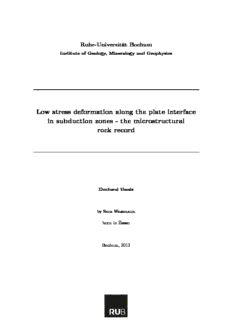
Low stress deformation along the plate interface in subduction zones PDF
Preview Low stress deformation along the plate interface in subduction zones
Ruhr-Universit¨at Bochum Institute of Geology, Mineralogy and Geophysics Low stress deformation along the plate interface in subduction zones - the microstructural rock record Doctoral thesis by Sara Wassmann born in Essen Bochum, 2012 Ruhr-Universit¨at Bochum Institute of Geology, Mineralogy and Geophysics Low stress deformation along the plate interface in subduction zones - the microstructural rock record Doctoral thesis by Sara Wassmann Faculty of Geosciences Ruhr-Universit¨at Bochum Thesis committee Prof. Bernhard St¨ockhert Prof. Claudia A. Trepmann Prof. Ju¨rgen Schreuer Defense of doctoral thesis April 19, 2012 Declaration of Authorship I hereby declare in lieu of an oath that I have written this thesis independently and autonomously using only the sources indicated. - - - - - - - - - - - - - - - - - - - - - - - - - - - - - - - - - - - - - - - - Location, Date Signature Many fine books have been written in prison. Raoul Duke Summary The present study investigates microstructures of high pressure - low temper- ature (HP-LT) metamorphic rocks from geological settings that are understood to represent ancient subduction channels. Deformation mechanisms activated under specific conditions leave an unequivocal imprint reflecting stress history and ma- terial behaviour at depth. Interpretation of these microstructures, combined with petrological evidence of metamorphic conditions during burial and exhumation, al- lows for inferences on the mechanical state of modern subduction zones at depth, following the principle of uniformitarianism. In this case implications are made for the rheology of the plate interface in subduction zones using the microstructural record of three different rock types. Analytical methods include polarization mi- croscopy (transmitted and reflected light), scanning electron microscopy (SEM) in backscattered mode, SEM combined with an energy dispersive X-ray (EDX) analyti- cal system, SEM combined with electron backscattered diffraction (EBSD), electron microprobe analysis, and X-ray powder diffraction. Schistose and compositionally layered HP metamorphic serpentinites (P ≈ 2 ± (cid:176) 0.5 GPa, T ≈ 550 ± 50 C) from the Zermatt-Saas zone, Western Alps, are investi- gated in the first case study. Serpentinites being believed to play an essential role for the development of a subduction channel, the microstructural record provides information on large scale flow processes and rheology at inaccessible depth. The serpentinites exhibit small scale folding, and crenulation cleavage with depletion of olivine in the fold limbs and precipitation of olivine at dilatants sites in the fold hinges. Prismatic strain shadows formed in between clinopyroxene porphyroclasts broken and drifted apart and wedge-shaped strain shadows flank the sides of these porphyroclasts.Togetherwiththeabsenceofevidencefordeformationbydislocation creep,thesemicrostructuresindicatethathighstrainwasessentiallyaccumulatedby dissolution precipitation creep. This implies low viscosity and a Newtonian rheology for hydrated mantle material in deeper levels of subduction zones. A highly deformed jadeite-blueschist from the Franciscan Complex (P > 1 - 1.4 (cid:176) GPa, T ± 300 - 450 C) represents matrix material of a block in matrix structure from a tectonic m´elange. While blocks of varying size floating in a weak matrix re- main undeformed, the matrix is thought to take up the deformation and to control the rheology. The investigated specimen exhibits a transposed foliation that is char- acterized by dismembered fold hinges and boudinage structures. Strain shadows and strain caps developed at large jadeite grains. Microstructures of veins in fragmented jadeite grains are sealed by quartz and healed by new jadeite epitactically grown on the broken host. This indicates that the fractures were open before healing and sealing occurred at HP metamorphic conditions. The shape of small veinlets that formed at HP metamorphic conditions and crosscut specific layers, indicates dis- tributed host rock deformation during and after sealing. Monophase glaucophane aggregates consist of extremely thin (down to 100 nm) undeformed needles and ex- hibit open pores indicating the presence of an aqueous fluid, which is also preserved as abundant fluid inclusions in quartz. The predominant deformation mechanism at HP-LT metamorphic conditions is dissolution precipitation creep. Low flow strength and a very low viscosity of material in the interplate shear zone are inferred. A graphitic micaschist from the Tauern window, Eastern Alps, contains large poikiloblastic garnet crystals grown during maximum burial at pressures of 2.0 - (cid:176) 2.5 GPa and temperatures close to 600 C. Microstructures developed during burial are preserved inside the garnet poikiloblasts. Strain shadows flanking these garnets (cid:176) formed in a narrow P-T field spanning from ca. 1.7 GPa at 570 C to ca. 0.9 GPa at (cid:176) 470 C,indicatingongoingdeformationbydissolutionprecipitationcreepduringearly exhumation. Dissolution seams, in places stylolitic, developed between converging garnets. The less soluble material, passively enriched in these seams (mainly white mica and graphite), was originally included in the dissolving garnet. The preserved delicate microstructures suggest that garnet dissolution proceeded at low stress. Independent of burial depth and type of material, the microstructural record of rocks exhumed from ancient subduction channels imply that the overall deforma- tion is governed by dissolution precipitation creep. An aqueous fluid must have been present throughout. Deformation by dissolution precipitation creep permits defor- mation to be localized into narrow shear zones and allows for viscous flow at low temperatures. As shear heating is understood to be negligible for material with low viscosity, this correlates well with the cool geotherms inferred for subduction zones. The three case studies on HP metamorphic rocks presented here imply low differ- ential stress, low flow strength and a Newtonian rheology for material undergoing deformation to high strain along the interface in subduction zones.
Description: